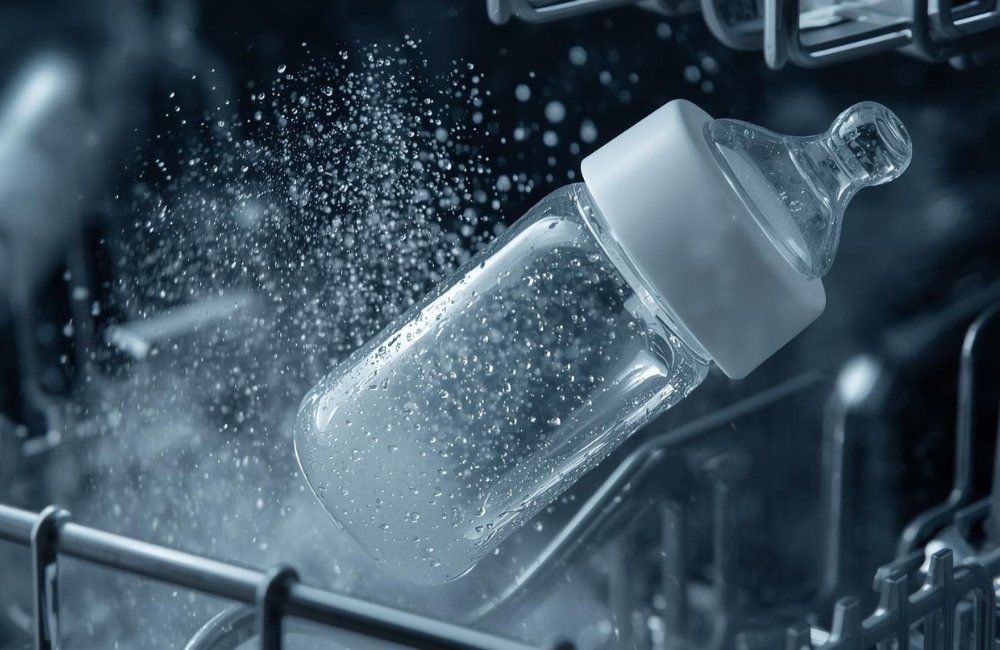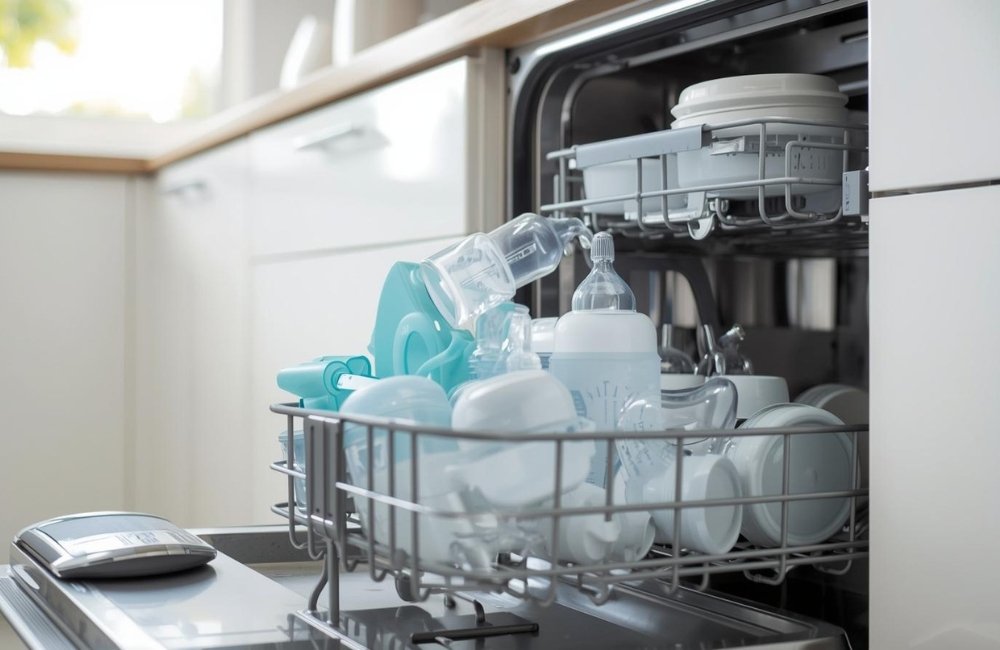Parents prefer baby bottles that are safe, durable, and easy to clean. But when it comes to using the dishwasher, many wonder if it’s really safe. The answer is yes, most baby bottles are dishwasher-safe. Still, there are a few important guidelines and precautions to follow to make sure the bottles remain hygienic and in good condition. Let’s go through the details.
Are Baby Bottles Dishwasher-Safe?
Yes, many baby bottles are dishwasher-safe, but it often depends on the material. Glass bottles are highly resistant to heat and can withstand most dishwasher cycles, making them a popular choice for busy parents. Unlike plastic, glass does not release chemicals or retain odors, even when exposed to high temperatures. A Babylist survey found that in 2024, 41% of parents preferred glass bottles over plastic for safety and quality reasons, and this preference rose to 50% by 2025.

The dishwasher is usually safe, but the accessories are the problem:
-
- Nipples and vents: Nipples and vents are made of silicone and can be washed in the top rack of your dishwasher. But in hot weather, latex nipples are easier to wear out, so inspect them every now and then.
-
- Cases, collars, rings, and caps: These are often made of polypropylene-based or plastic materials and are dishwasher safe, although they may distort over time.
-
- Printed measurement marks: Painted or printed lines may be lost due to repeated cycles. For long-term accuracy, use bottles that have either etched or molded marks.
How to Wash Baby Bottles in the Dishwasher? (Step-by-Step)

Cleaning baby bottles isn’t just about convenience—it’s also about hygiene. The dishwasher does an excellent job, but only if bottles are prepared and loaded correctly. Follow these steps:
- Prep
Wash bottles immediately after feeding to prevent milk residue from drying.
Take all the parts apart: bottle, nipple, collar, vent, cap, and straw.
Apply a bottle brush on tough spots prior to loading. - Load
Bottles must be placed standing on the upper level and not in contact with the heating.
Place nipples, vents and miscellaneous items in a dishwasher-safe basket.
Don’t overcrowd to get even coverage of the spray. - Cycle
Wash a full load or a full washing of water.
Additional protection includes use of the sanitize mode (150-160 °F / 65-70 C). - Detergent
Wash with a light, scent-free, colorless laundry detergent.
Avoid using bleach, vinegar, or antibacterial additives, as they may cause damage to silicone or plastic. - Dry
Allow to dry completely on a clean rack to avoid moulding.
Forget about using dish towels- they can spread bacteria.
Heated-dry will not harm glass but can reduce the life of silicone parts.
Sanitize vs. Sterilize: What’s the Difference?
| Sanitize | Sterilize |
| Reduces germs to safe levels (not all) | Suitable for most healthy babies after the newborn stage |
| Dishwasher sanitize cycle, hot water, or hygiene settings | Boiling (5 min), steam sterilizer, microwave steam bags, or UV |
| Extra steps are required but ensure full protection | Essential for newborns, preemies, or babies with weak immunity |
| Convenient but not 100% germ-free | Extra steps are required but ensures full protection |
| Use daily for babies 3–6+ months | Required for newborns, preemies, or illness |
Can You Put Baby Bottles in the Dishwasher with Other Dishes?
Yes, baby bottles can be washed with other dishes with care. Remove food from plates and utensils, and scrap off any residue from bottles that have been in contact with greasy pans or objects that have come into contact with uncooked meat to prevent contamination. Do not put water in to flow freely, and remember to load all bottles and accessories in the top rack for safety.
Do You Need to Sterilize Baby Bottles After the Dishwasher?
In most healthy infants, the response is no- a dishwasher load with a sanitize option is normally sufficient. Nevertheless, sterilization is still advised when your baby is below 3 months old, a preterm baby, or when advised to by your pediatrician. However, there are parents who sterilize bottles, sometimes even after washing them in the dishwasher, particularly when there is illness or when traveling to areas where there is no guarantee of good water. This is an additional measure but may offer some relief and greater security.
Can You Put Baby Bottles in the Dishwasher to Sterilize?
No. Dishwashers sanitize but do not guarantee full sterilization. If sterilization is needed, use one of these methods:
-
- Boiling water (5 minutes)
-
- Electric steam sterilizer
-
- Microwave steam bags
-
- UV sterilizer
When Can I Stop Sterilizing Bottles?
Several parents are able to discontinue daily sterilization at 3 to 6 months, when infants start to mouth toys and other objects. Nevertheless, proceed with sterilization when recommended by your pediatrician, especially if your infant is unwell or resides in a locality with low water quality. In the case of formula-fed infants, certain specialists suggest sterilizing for a little longer: up to 12 months, since powdered formula is not sterile and its preparation requires utmost safety. Once this step is completed, sanitizing with soap and water or a dishwasher’s sanitize cycle is generally sufficient; however, periodic sterilization due to illness is a comforting factor.
Key Safety & Maintenance Tips for Baby Bottles
Replace Nipples When Needed
Nipples also wear out and can present safety problems. If you notice cracks, stickiness, thinning, or discoloration, replace them to ensure feeding is hygienic and comfortable for your baby. Digestive comfort is also assisted by proper feeding accessories that can help to naturally reduce burping in babies by reducing air intake.
Inspect Small Parts Regularly
Silicone valves, O-rings, and vent systems may have weakened or been filled with residue. Monitor them and change them when the first signs of damage appear to avoid leakage and contamination.
Prevent Mold with Proper Drying
Molds thrive in moisture. Always leave bottles and accessories to dry completely in a clean rack, and then reassemble or store them.
Sterilize During Illness or Poor Water Quality
You may not need to sterilize every day, but it is always safe to sterilize bottles when your child is sick or when you are unsure about the quality of your tap water. This gives an extra security.
FAQs
How to Sanitize a Glass Baby Bottle?
Wash bottles with the dishwasher on a sanitize setting, or use hot, soapy water followed by a hot rinse.
Is it safe to put newborn bottles in the dishwasher?
Yes, except that when the babies are less than 3 months, it is best to wash them and then sterilize as well.
What dishwasher setting is best for baby bottles?
Select a hot water or sanitize item on the upper rack.
Can baby bottle nipples go in the dishwasher?
Yes, silicone nipples are top rack safe, but latex lasts shorter.
Do I need to sterilize baby bottles after every use?
No, not healthy older babies; sterilization is most frequently required to newborns, preemies, or as advised by the pediatrics.


